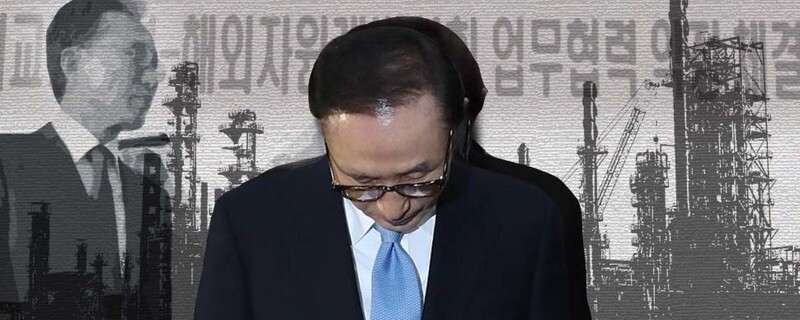hankyoreh
Links to other country sites 다른 나라 사이트 링크
Government asks prosecutors to investigate overseas development projects under Lee Myung-bak

The South Korean government has asked the prosecutors to investigate three overseas resource development projects – including the Korean National Oil Corporation’s (KNOC) acquisition of Harvest Energy – which resulted in astronomical losses during the administration of ex-president Lee Myung-bak. After reviewing the government’s request, the prosecutors are planning to assign the cases to the relevant departments.
South Korea’s Ministry of Trade, Industry and Energy (MOTIE) announced on May 29 that it had asked the prosecutors to investigate a KNOC project involving Harvest Energy, a Korea Gas Corporation (KOGAS) project involving Horn River and West Cutbank and a Korea Resources Corporation (KORES) project involving the Boleo copper mine.
This past November, MOTIE put together a team of private sector experts – called the Task Force for Innovation in Overseas Industrial Development – to look into poor management of past overseas resource development projects. Harvest Energy is an oil refining company that KNOC bought for 4.55 trillion won (US$4.21 billion) after just 44 days of M&A negotiations. Though KNOC had originally intended to only acquire the more profitable upstream portion (the mining area), the negotiations resulted in an abrupt package agreement that included the downstream portion (the refinery), which was one of the reasons KNOC suffered trillions of won in losses.
Allegations have even been raised that Choi Kyoung-hwan, who was then in charge of the Ministry of Knowledge Economy (the forerunner of the MOTIE), had gotten involved in the acquisition process. The MOTIE has reportedly turned up evidence that not only Choi but other key figures in the Lee administration meddled in that process.
Before KOGAS acquired Canadian gas wells at Horn River and West Cutbank in 2009 as part of a well development and production project, a feasibility review found that the internal rate of return, which is used to estimate future profitability, did not meet requirements. But KOGAS rashly pushed ahead with the project nonetheless. The Board of Audit and Inspection noted that in Oct. 2014 the internal rate of return for the West Cutbank mining area was 9.2 percent, which fell below the 10 percent requirement for investment feasibility, but KOGAS combined this with the Horn River mining area to calculate an internal rate of return of 12.6 percent.
The Boleo project in Mexico was one of the infamous failures that resulted in KORES’s total capital impairment. Even in KORES’s own assessment, the mine’s acquisition in 2008 was followed by astronomical losses because the mine’s presumed productivity far exceeded the industry average. Another mystery is how KORES’s share in the mine increased from 10 percent to 38.3 percent in Aug. 2012, more than three years after acquisition, and then up to 70 percent that October.
“We asked the prosecutors to carry out an investigation because our review of the stories of employees who worked at KORES at the time and M&A documentation suggest that there are aspects that need to be clearly addressed through such an investigation,” said a senior official from MOTIE.
Another view is that MOTIE has passed the buck to the prosecutors because it was unable to get any tangible results despite putting together a task force and carrying out an inquiry that lasted nearly half a year.
By Choi Ha-yan, staff reporter
Please direct comments or questions to [english@hani.co.kr]

Editorial・opinion
![[Column] Season 2 of special prosecutor probe may be coming to Korea soon [Column] Season 2 of special prosecutor probe may be coming to Korea soon](https://flexible.img.hani.co.kr/flexible/normal/500/300/imgdb/original/2024/0426/3317141030699447.jpg) [Column] Season 2 of special prosecutor probe may be coming to Korea soon
[Column] Season 2 of special prosecutor probe may be coming to Korea soon![[Column] Park Geun-hye déjà vu in Yoon Suk-yeol [Column] Park Geun-hye déjà vu in Yoon Suk-yeol](https://flexible.img.hani.co.kr/flexible/normal/500/300/imgdb/original/2024/0424/651713945113788.jpg) [Column] Park Geun-hye déjà vu in Yoon Suk-yeol
[Column] Park Geun-hye déjà vu in Yoon Suk-yeol- [Editorial] New weight of N. Korea’s nuclear threats makes dialogue all the more urgent
- [Guest essay] The real reason Korea’s new right wants to dub Rhee a founding father
- [Column] ‘Choson’: Is it time we start referring to N. Korea in its own terms?
- [Editorial] Japan’s rewriting of history with Korea has gone too far
- [Column] The president’s questionable capacity for dialogue
- [Column] Are chaebol firms just pizza pies for families to divvy up as they please?
- [Column] Has Korea, too, crossed the Rubicon on China?
- [Correspondent’s column] In Japan’s alliance with US, echoes of its past alliances with UK
Most viewed articles
- 1[Column] Season 2 of special prosecutor probe may be coming to Korea soon
- 2No good, very bad game for Korea puts it out of Olympics for first time since 1988
- 3‘We must say no’: Seoul defense chief on Korean, USFK involvement in hypothetical Taiwan crisis
- 4Korea’s 1.3% growth in Q1 signals ‘textbook’ return to growth, says government
- 5Division commander ordered troops to enter raging flood waters before Marine died, survivor says
- 6Is N. Korea threatening to test nukes in response to possible new US-led sanctions body?
- 7Is Japan about to snatch control of Line messenger from Korea’s Naver?
- 8[Editorial] In the year since the Sewol, our national community has drowned
- 9[Editorial] 10 years on, lessons of Sewol tragedy must never be forgotten
- 10[Editorial] New weight of N. Korea’s nuclear threats makes dialogue all the more urgent